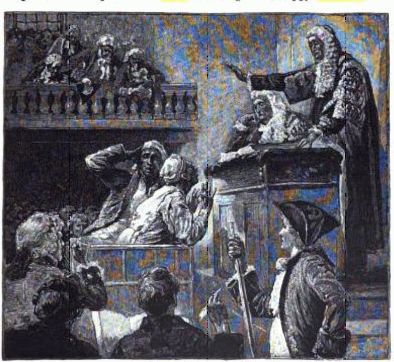In 1741, New York had a population of around 10,000 people, some 2,000 of whom were slaves. In a winter of harsh weather, food shortages and difficult economic times, worries about attacks on the Province by the Catholic countries of France and Spain abounded. Reports of slave revolts in other colonies added to the tension.
On March 8, 1741, a fire broke out at Fort George, the official residence of the Province’s governor, and the building burned to the ground. Nine more serious fires occurred in the weeks that followed, and the population of the city was in a state of panic. Supreme Court of Judicature Justice Daniel Horsmanden, was charged with leading an inquiry into the origins of the fires. The court convened in City Hall on April 21, 1741 and a grand jury was empaneled for the investigation. One of the first witnesses to be examined was a young servant named Mary Burton. She was indentured to John Hughson who ran a bar frequented by slaves and sailors in the vicinity of Trinity church.
Initially, Mary was reluctant to testify, but when she was threatened with confinement in the jail in City Hall, she gave evidence about a robbery that had occurred in February of that year at a small shop owned by Mrs. Hogg in Broad Street. The robbery was instigated by a sailor named Wilson but was carried out by three slaves, Ceasar, Prince, and Cuffee, whom Wilson had met at John Hughson’s bar. She also testified against Hughson, who was suspected of receiving stolen property.
Following further threats from Justice Horsmanden and inducements that promised an end to her indenture and financial award, Mary Burton began to testify to a plot that up to then, she had never mentioned. She told of a plan by a group of people to burn the city and murder its inhabitants. Those she named included the three slaves against whom she had testified on the charge of stealing, and John Hughson and his wife. Based on her testimony, the slaves named Caesar and Prince were charged with the February burglary (but not with the alleged plot), found guilty and sentenced to death. The following day, a fire resulted in the destruction of several barns and two slaves caught in the vicinity were immediately burned at the stake.
On May 11, the trials of the others accused by Mary Burton of involvement in the plot commenced. The judges of the court were James De Lancey, Daniel Horsmanden, and Frederick Philipse. Ever-escalating rounds of arrests, naming of others as conspirators, further arrests and further accusations, began. By the time it ended, some two hundred people had been tried in the Supreme Court of Judicature. Although many appeared for the prosecution, none of the lawyers in New York were willing to represent those accused in the plot, whether slave or white. Based upon questionable testimony, thirty people were sentenced to death and seventy others to slavery in the Caribbean. Among those executed were John Hughson, his wife Sarah and his daughter, also called Sarah.
Judge Horsmanden, as indicated above, served as both principal investigator and a judge of the court that heard the cases. With his professional reputation at stake, he published a journal describing the proceedings, which historian Jill Lepore described as “one of the most startling and vexing documents in early American history.”
Historians William Bryant and Sydney Gay condemned the entire proceedings, stating that “its disregard of all rules of legal evidence, for its prostitution of the forms of law for the perpetration of cruelty, for popular credulity and cowardice, for the abnegation of all sense of mercy, for the oppression of the weakest and most defenceless, it was without precedent, and has had no parallel in any civilized community.”
Sources
Paul Finkelman. Encyclopedia of African American History, 1619-1895, Volume 2 (2009)
Jill Lepore. New York Burning: Liberty, Slavery, and Conspiracy in Eighteenth-Century New York (2005)
William Cullen Bryant, Sydney Howard Gay. A Popular History of the United States. Volume 3 (1879)

